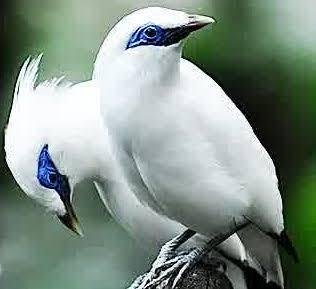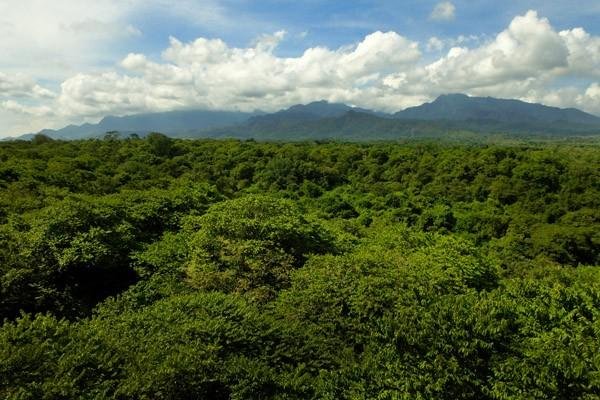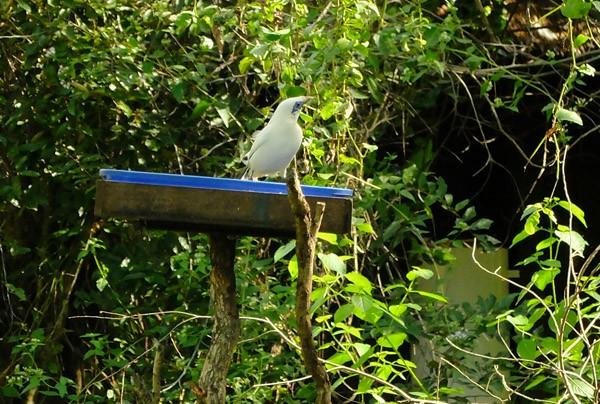Jalak Bali (Bali Starling)
The Bali myna (Leucopsar rothschildi), also known as Rothschild's mynah, Bali starling, or Bali mynah, locally known as jalak Bali, is a medium-sized (up to 25 centimetres (9.8 in) long), stocky myna, almost wholly white with a long, drooping crest, and black tips on the wings and tail. The bird has blue bare skin around the eyes, greyish legs and a yellow bill. Both sexes are similar. It is critically endangered and fewer than 100 adults are assumed to currently exist in the wild.[1]

Jalak Bali or Leucopsar rothschildi, in the area of origin of the island of Bali commonly called Curik. Bali Starling is only found on the island of Bali. Although it was once found in the island of Lombok, but the presence of birds in lombok allegedly only to migrate temporarily to the island, and until now on the island of Lombok can never be found the bird, so we can take the conclusion that this Bali Starling bird only exist on the island of Bali and become characteristic of Balinese natural wildlife.
Scientific classification
Kingdom : Animalia
Phylum : Chordata
Class : Aves
Order : Passeriformes
Family : Sturnidae
Genus : Leucopsar Stresemann, 1912
Species : L. rothschildi
Binomial name : Leucopsar rothschildi Stresemann, 1912 [1]
Characteristic of Bali Starling
What are the characteristics of Bali Starling? If we notice that this bird has special features, such as white color throughout the body except at the tip of the tail and wings are black. Then on the cheeks are not overgrown, bright blue and grayish legs.
Between male and female birds, we can hardly distinguish them because they are exactly the same, the only way to distinguish them from the size of the male form is usually larger than the female, as well as the crest on the more erect head of the female bird.
First Invention of Jalak Bali
Bali starlings were first discovered by an expert from the United Kingdom on March 24, 1911. The naming of Rothscildi in the Latin name of Bali starling is given as a tribute to the British bird expert Walter Rothschild who described the bird in 1912.
Jalak Bali (Leucopsar rothschildi) is one of endemic animals in Indonesia and is a special species of Bali, Bali. This bird, being one of Bali's remaining species after the Bali tiger that has been declared extinct.
The Cause of the Rare Bali Starling
Lots of causes from the scarcity of wildlife populations, can occur due to unnatural causes. Examples of behavior or human behavior that is so excessive behavior can not keep the environment well. Probably because they do not understand how to preserve the environment well.
There are also other examples that humans often do such as poaching and this will certainly transform a habitat from wildlife into other functions. And of course, causing the existing animals become increasingly pressed and the population is declining, so it can be scarcity of various kinds of animals that exist.

The scarcity of Bali Starling birds from other factors is the habitat quality that is getting more and more destroyed. There are also other factors due to predators, diseases, competing animals, or death because of old age. But of course of all these factors of course we as the inhabitants of this nature has an obligation to keep it well. In order for the ecosystem to remain well preserved do not let any more animals are missing species.
The Efforts to keep Bali Starling
There has been a lot of effort undertaken by the government or agencies involved in the environment that make efforts to protect Bali Starling from destruction. Because it includes the type of bird singing, because the population of this white-haired bird in the wild declined, due to the widespread poaching.

The bird, whose latin name Leucopsar rotschildii, is thought to have only left about 100-200 tails from 1980 to 1990. From this incident to awakening the consciousness of a number of parties to begin to initiate the attempts to rescue this native Balinese from the threat of extinction.
One of them is done in the development of this Bali starling, as well as one of the tourist attraction developed by Menjangan Resort in the West Bali National Park, to attract tourists. Through this program, the number of endangered birds is now slowly starting to grow. And this is one very good program. If we come to bali we will be able to see firsthand how the beautiful way to develop this Bali starling habitat.
Conclusion
Jalak bali is one of the rare animals that we always have to keep the habitat. So with the development of breeding in conservation agencies and bali starlings, the presence of the number of Bali starlings in Bali can be said to increase from year to year, so support for conservation efforts must be improved.
So that in the future it is expected through captive breeding, restocking to nature / habitat which is one of the obligations that must be fulfilled by the breeder can be realized properly. Thus expected, the number of starlings in nature in the future will increase. And until whenever there is no more animals that just stay the name while the species can no longer we see directly.